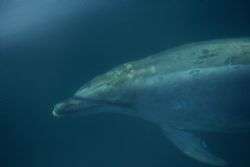The bottlenose dolphin only colonised the Mediterranean after the last Ice Age - about 18,000 years ago – according to new research.
Leading marine biologists collaborated in the study - the most detailed ever conducted into the genetic structure of the bottlenose dolphin population in the Mediterranean to date – and the results have been published today 17th February, 2015 in the journal Evolutionary Biology.
Tissue samples from 194 adult bottlenose dolphins (Tursiops truncatus) were collected between 1992 and 2011 from the five main eastern Mediterranean basins.
The team's aim was to investigate the population structure and historical processes that may be responsible for the geographic distribution of the species in that area. No other study has compared the fine scale genetic structure within the Mediterranean, with the well described genetic structure in the North Atlantic.
The Mediterranean basin in particular is a global biodiversity hotspot and several marine species exhibit complex population structure patterns over relatively short geographic distances. It is therefore a particularly interesting region for scientists to investigate the drivers of population structure in marine organisms.
One of the study's lead authors Dr Andre Moura, from the School of Life Sciences, University of Lincoln, UK, said: "As a consequence of the bottlenose dolphin only colonising the Mediterranean after the last glacial maximum or Ice Age, population structure in the Mediterranean mainly arises from the different colonisation routes the various early colonisers took, and the genetic varieties they carried.
"Similar to the North Atlantic, two ecological types are likely to exist, one occupying deep 'pelagic' - or away from the coast - waters, and another occupying 'coastal' shallow water areas. By comparing our results with genetic data from previous studies on Atlantic bottlenose, we concluded that bottlenose dolphin in the North Atlantic, Mediterranean and North Sea are likely to represent a single metapopulation - This is a particular type of population structure, when a single population is subdivided into regional subgroups that exchange individuals at varying rates. These results have important implications for the understanding and conservation of Mediterranean biodiversity."
More information: "Drivers of Population Structure of the Bottlenose Dolphin (Tursiops truncatus) in the Eastern Mediterranean Sea Evolutionary Biology." link.springer.com/article/10.1 … 07/s11692-015-9309-8
Journal information: Evolutionary Biology
Provided by University of Lincoln
























